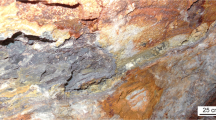Abstract
Attikaite, a new mineral species, has been found together with arsenocrandalite, arsenogoyazite, conichalcite, olivenite, philipsbornite, azurite, malachite, carminite, beudantite, goethite, quartz, and allophane at the Christina Mine No. 132, Kamareza, Lavrion District, Attiki Prefecture (Attika), Greece. The mineral is named after the type locality. It forms spheroidal segregations (up to 0.3 mm in diameter) consisting of thin flexible crystals up to 3 × 20 × 80 μm in size. Its color is light blue to greenish blue, with a pale blue streak. The Mohs’ hardness is 2 to 2.5. The cleavage is eminent mica-like parallel to {001}. The density is 3.2(2) g/cm3 (measured in heavy liquids) and 3.356 g/cm3 (calculated). The wave numbers of the absorption bands in the infrared spectrum of attikaite are (cm−1; sh is shoulder; w is a weak band): 3525sh, 3425, 3180, 1642, 1120w, 1070w, 1035w, 900sh, 874, 833, 820, 690w, 645w, 600sh, 555, 486, 458, and 397. Attikaite is optically biaxial, negative, α = 1.642(2), β = γ = 1.644(2) (X = c) 2V means = 10(8)°, and 2V calc = 0°. The new mineral is microscopically colorless and nonpleochroic. The chemical composition (electron microprobe, average over 4 point analyses, wt %) is: 0.17 MgO, 17.48 CaO, 0.12 FeO, 16.28 CuO, 10.61 Al2O3, 0.89 P2O5, 45.45 As2O5, 1.39 SO3, and H2O (by difference) 7.61, where the total is 100.00. The empirical formula calculated on the basis of (O,OH,H2O)22 is: Ca2.94Cu 2+1.93 Al1.97Mg0.04Fe 2+0.02 [(As3.74S0.16P0.12)Σ4.02O16.08](OH)3.87 · 2.05H2 O. The simplified formula is Ca3Cu2Al2(AsO4)4(OH)4 · 2H2O. Attikaite is orthorhombic, space group Pban, Pbam or Pba2; the unit-cell dimensions are a = 10.01(1), b = 8.199(5), c = 22.78(1) Å, V = 1870(3) Å3, and Z = 4. In the result of the ignition of attikaite for 30 to 35 min at 128–140°, the H2O bands in the IR spectrum disappear, while the OH-group band is not modified; the weight loss is 4.3%, which approximately corresponds to two H2O molecules per formula; and parameter c decreases from 22.78 to 18.77 Å. The strongest reflections in the X-ray powder diffraction pattern [d, Å (I, %)((hkl)] are: 22.8(100)(001), 11.36(60)(002), 5.01(90)(200), 3.38(5)(123, 205), 2.780(70)(026), 2.682(30)(126), 2.503(50)(400), 2.292(20)(404). The type material of attikaite is deposited in the Fersman Mineralogical Museum, Russian Academy of Sciences, Moscow. The registration number is 3435/1.
Similar content being viewed by others
References
P.-J. Chiappero and H. Sarp, “Zdenekite, a New Mineral from the Cap Garonne Mine,” Eur. J. Mineral. 7, 553–558 (1995).
M. A. Cooper and F. C. Hawthorne, “Highly Undersaturated Anions in the Crystal Structure of Andyrobertsite-Calcio-Andyrobertsite, a Doubly Acid Arsenate of the Form K(Cd,Ca)[Cu5(AsO4)4{As(OH)2O2}](H2O)2,” Can. Mineral. 38, 817–830 (2000).
M. A. Cooper, F. C. Hawthorne, W. W. Pinch, and J. D. Grice, “Andyrobertsite and Calcio-Andyrobertsite: Two New Minerals from the Tsumeb Mine, Tsumeb, Namibia,” Miner. Record 30, 181–186 (1999).
C. Guillemin, “Contribution a la minéralogie des phosphates et vanadates de cuivre. I. Arséniates de arséniates, cuivre,” Bull. Minér. 79, 7–95 (1953).
D. Yu. Pushcharovsky, N. I. Zubkova, S. J. Taet, et al., “Crystal Structure of Mahnertite,” Eur. J. Mineral. 16, 687–692 (2004).
H. Sarp, “La Mahnertite, (Na,Ca)Cu3(AsO4)2Cl5H2O, un Nouveau Minéral de la Mine Cap Garonne, Var (France),” Arch. Sci. Genéve 49/2, 119–124 (1996).
H. Sarp and R. Černý, “Calcio-Andyrobertsite-2O, KCaCu5(AsO4)4[AsO2(OH)2] · 2H2O: Its Description, Crystal Structure and Relation with Calcio-Andyrobertsite-2M,” Eur. J. Mineral. 16, 163–169 (2004).
N. I. Zubkova, D. Yu. Puscharovsky, S. J. Teat, et al., “Crystal Structures and Topology of Two Copper Arsenates: Zdenekite and Mahnertire,” in Proceedings of the 22nd Eur. Crystallogr. Meeting (Budapest, Hungary, 2004).
N. I. Zubkova, D. Yu. Pushcharovsky, S. J. Teat, et al., “Crystal Structures and Topology of New and Rare Arsenates,” in Proceedings of the XX Congess of the Intern. Union of Crystallogr. Congress and General Assembly (Florence, Italy, 2005).
N. I. Zubkova, D. Yu. Pushcharovsky, H. Sarp, et al., “Crystal Structure of Zdenekite NaRbCu5(AsO4)4Cl · 5H2O,” Kristallografiya 48(6), 1006–1011 (2003) [Crystallogr. Rep. 48, 939–943 (6) (2003)].
Author information
Authors and Affiliations
Corresponding author
Additional information
A new mineral attikaite and its name were accepted by the Commission on New Minerals and Mineral Names, Russian Mineralogical Society, March 30, 2006. Approved by the Commission on New Minerals and Mineral Names, International Mineralogical Association, July 1, 2006. IMA no 2006-017.
Original Russian Text © N.V. Chukanov, I.V. Pekov, A.E. Zadov, 2007, published in Zapitski Rossiiskogo Mineralogicheskogo Obshchestva, 2007, Pt CXXXVI, No. 2, pp. 17–24.
Rights and permissions
About this article
Cite this article
Chukanov, N.V., Pekov, I.V. & Zadov, A.E. Attikaite, Ca3Cu2Al2(AsO4)4(OH)4 · 2H2O, a new mineral species. Geol. Ore Deposits 49, 720–726 (2007). https://doi.org/10.1134/S1075701507080065
Received:
Issue Date:
DOI: https://doi.org/10.1134/S1075701507080065



